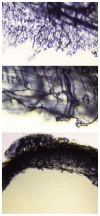Meniscus tear surgery and meniscus replacement
- PMID: 27331034
- PMCID: PMC4915465
- DOI: 10.11138/mltj/2016.6.1.071
Meniscus tear surgery and meniscus replacement
Abstract
Objective: the menisci are easily injured and difficult to repair. The aim of this study was to analyze the current state of meniscal surgery aimed at preserving morphology and conserving the biomechanics of the knee to prevent joint degeneration.
Methodology: a search of the electronic medical literature database Medline was conducted, from http://www.ncbi.nlm.nih.gov/pubmed. The search was not limited by language. Candidate articles were identified by searching for those that included the keywords meniscus, surgery, suture, implant, allograft. The limits were included for clinical research and clinical trials. Basic research was not included. The studies selected were evaluated and classified in three different categories: basic science, reconstruction (suture and meniscectomy) and implants (scaffolds and allograft).
Results: the consequences of meniscectomy performed at a young age can lead to a joint cartilage degeneration twenty years later. There are few surgical options for the repair of meniscal injuries in order both to preserve the meniscus and to ensure the long term survival of the knee joint, meniscectomy, repair, suturing the tear, or reconstruction, when a meniscal allograft or synthetic substitute is used to replace the meniscus, but the biomechanical properties of the native meniscus are not reproduced entirely by the scaffolds that exist today.
Conclusion: therapies that successfully repair or replace the meniscus are therefore likely to prevent or delay osteoarthritis progression.
Keywords: allograft; knee; meniscus; scaffolds; suture.
Figures









References
-
- Kambic HE, Futani H, McDevitt CA. Cell matrix changes and alpha-smooth muscle actin expresion in repair of the canine meniscus. Wound Repair Regen. 2000;8:554–561. - PubMed
-
- Potenza A, Herte M. The synovial cavity as a “tissue culture in situ”: Science or nonsense. J Hand Surg. 1982;7:196–199. - PubMed
-
- Veth R, Jansen H, Leenslang J, Pennings A. Experimental meniscal lesions reconstructed with a carbon fiber-polyurethane-poly (L-lactide) graft. Clin Orthop Relat Res. 1986;202:286–293. - PubMed
-
- Englund M, Roos EM, Roos HP, Lohmander LS. Patient-relevant outcomes fourteen years after meniscectomy: influence of type of meniscal tear and size of resection. Rheumatology. 2001;40:631–639. - PubMed
-
- Forriol F, Longo UG, Hernández-Vaquero D, Monllau JC, Montserrat F, Valentí JR, Vaquero J, et al. The effects of previous meniscus and anterior cruciate ligament injuries in patients with total knee arthroplasty. Ortop Traumatol Rehabil. 2010;12:50–57. - PubMed
Publication types
LinkOut - more resources
Full Text Sources
Other Literature Sources
